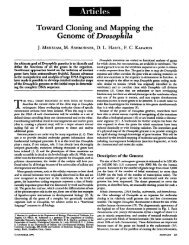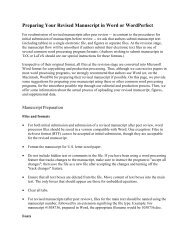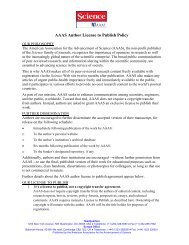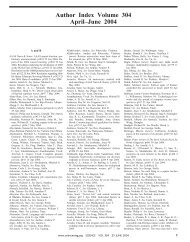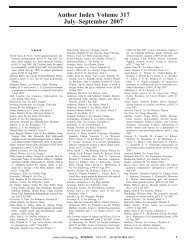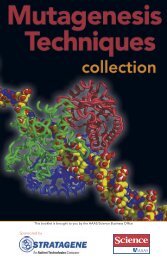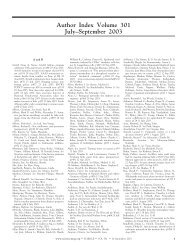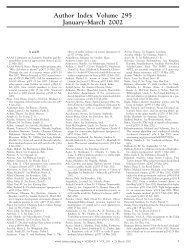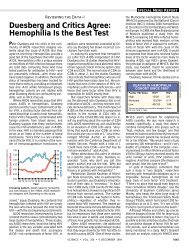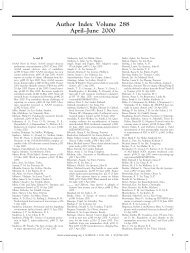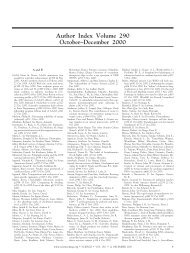Chinese Academy of Sciences (PDF) - low res version
Chinese Academy of Sciences (PDF) - low res version
Chinese Academy of Sciences (PDF) - low res version
Create successful ePaper yourself
Turn your PDF publications into a flip-book with our unique Google optimized e-Paper software.
CREDITS: (FROM TOP) COURTESY OF THE INSTITUTE OF MODERN PHYSICS, CAS;<br />
COURTESY OF THE INSTITUTE OF PLASMA PHYSICS, CAS<br />
Research CAS/In Focus<br />
The Heavy Ion Research Facility in Lanzhou.<br />
Heavy Ion Research Facility in Lanzhou<br />
The Heavy Ion Research Facility in Lanzhou (HIRFL) comprises <strong>of</strong><br />
the superconducting ECR ion source, the 1.7 m Sector Focused<br />
Cyclotron (SFC, K=69), the large Sector-Separated Cyclotron (SSC,<br />
K=450), the Cooler-Storage Main Ring (CSRm) and the Cooler-<br />
Storage Experimental Ring (CSRe) <strong>of</strong> the newly built Cooler-Storage<br />
Ring (CSR), and the radioactive ion beam lines (RIBLL1 and RIBLL2)<br />
and experimental terminals. It is capable <strong>of</strong> providing ion beams from<br />
protons to uranium with energies <strong>of</strong> up to 2,800 MeV/u and 1,000<br />
MeV/u for protons and heavy ions, <strong>res</strong>pectively. The studies in heavy<br />
ion physics and its related disciplines being carried out at HIRFL include<br />
fundamental <strong>res</strong>earch on heavy ion nuclear physics, radioactive ion<br />
beam physics, nuclear astrophysics, high energy density physics,<br />
highly charged atomic physics, hadronic physics, and experimental<br />
<strong>res</strong>earch in aerospace science and technology, materials science, and<br />
biomedicine.<br />
A number <strong>of</strong> fundamental <strong>res</strong>earch achievements have come out <strong>of</strong> the<br />
HIRFL accelerator complex, including the first direct mass measurements<br />
<strong>of</strong> short-lived nuclides, which provides the key to understanding the rapid<br />
proton capture process (rp process), one <strong>of</strong> the nuclear reactions that<br />
may be <strong>res</strong>ponsible for heavy element formation in the universe. Relative<br />
mass precision up to 10 -6 has been reached. In applied <strong>res</strong>earch, clinical<br />
trials for tumor therapy, which began in 2006, have successfully treated<br />
103 shal<strong>low</strong>-seated and 73 deep-seated<br />
tumor patients.<br />
The National Laboratory for the Heavy<br />
Ion Research Facility in Lanzhou (NHIRFL)<br />
was established in 1991. NHIRFL has<br />
provided advanced experimental conditions<br />
to over 160 users both in China and<br />
abroad, and has set up cooperative relationship<br />
with 40 well-known universities,<br />
<strong>res</strong>earch institutions, and high-technology<br />
enterprises.<br />
Contact: Pr<strong>of</strong>essor Liang Qiang,<br />
liangqiang@impcas.ac.cn<br />
Experimental Advanced<br />
Superconducting Tokamak<br />
Experimental Advanced Superconducting Tokamak<br />
(EAST) was designed based on the latest<br />
tokamak achievements <strong>of</strong> the past century.<br />
Its mission is to conduct cutting-edge physics<br />
and engineering <strong>res</strong>earch on advanced tokamak<br />
fusion reactors. This will provide a scientific<br />
base for experimental reactor design and<br />
construction, and promote the advancement<br />
<strong>of</strong> plasma physics and related disciplines and<br />
technologies. It has three distinct featu<strong>res</strong>: a<br />
noncircular cross-section, fully superconducting<br />
magnets, and fully actively water cooled<br />
plasma facing components (PFCs) which will be<br />
beneficial for exploring advanced steady-state<br />
plasma operation modes. Experience from the<br />
construction <strong>of</strong>, and <strong>res</strong>earch at, EAST will provide a foundation for the<br />
construction <strong>of</strong> the International Thermonuclear Experimental Reactor project<br />
(ITER).<br />
Aiming at long pulse plasma discharges, a series <strong>of</strong> experimental techniques<br />
have been developed or improved on EAST in recent years, such as<br />
ion cyclotron heating, plasma diagnostics and control, and lithium wall conditioning.<br />
Additionally, the effective heating and current drive were realized<br />
under a variety <strong>of</strong> plasma configurations, and the divertor operation was explored<br />
in the steady-state mode. Extensive international cooperation focusing<br />
on EAST shows that this project has become one <strong>of</strong> the most important<br />
physical experiment platforms for high-parameters long-pulse plasma.<br />
At p<strong>res</strong>ent, EAST also provides machine time to <strong>res</strong>earchers outside the<br />
Institute <strong>of</strong> Plasma Physics for different <strong>res</strong>earch purposes. Long-standing<br />
cooperative projects include: radio frequency heating <strong>res</strong>earch by the<br />
National Institute <strong>of</strong> Fusion Science (NIFS, Japan) and the Massachusetts<br />
Institute <strong>of</strong> Technology (MIT, United States); electron cyclotron emission,<br />
charge compound, and exchange spectrum <strong>res</strong>earch by the Fusion Research<br />
Center at Texas University (FRC, United States); balance control and<br />
advanced tokamak operation mode by the General Atomics (GA, United<br />
States). In the last EAST experiment campaign, over 100 foreign scientists<br />
participated in the experiment.<br />
Contact: Pr<strong>of</strong>essor Dong Shaohua, shdong@ipp.ac.cn<br />
The Experimental Advanced Superconducting Tokamak (EAST)<br />
31



